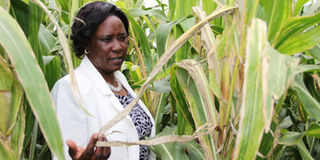We need regional efforts to defeat deadly maize disease

Sally Gari assesses the damage caused by maize necrosis disease in her farm in Nandi in 2013. FILE PHOTO | JARED NYATAYA | NATION MEDIA GROUP
What you need to know:
- Besides farmers, the stakeholders include seed companies, seed distributors, regulators, policymakers, scientists and extension services in all maize-growing countries, irrespective of whether or not maize lethal necrosis disease has been detected or reported in these countries.
- Uganda and Zimbabwe also ensure that all imported seeds are certified as maize lethal necrosis disease-free. This implies that other countries with weak surveillance and diagnostics are at high risk of importing infected seed.
- These practices include crop rotation, at least two months of maize-free period (meaning no maize growing on their farms in a synchronised manner across the village), timely planting, proper detection and prompt destruction of any infected plants, planting certified maize seeds, and crop diversification where possible.
The maize lethal necrosis disease continues to wreak havoc on production of the cereal through irreversible damage that kills the plants.
The disease is a regional problem reported in Kenya in Bomet County in 2011 as well as in DR Congo, Ethiopia, Rwanda, Tanzania, South Sudan and Uganda.
The disease causes yield losses of up to 10 per cent of the national maize production, which is equivalent to Sh4.8 billion ($50 million).
The spread of lethal necrosis disease in East Africa has been attributed to the wide prevalence of insects that transmit the disease, as well as to distribution and cultivation of infected seeds, making the disease difficult to control.
Lack of disease-resistant maize varieties and year-round cultivation of the crop exacerbates the situation. This is because continuous growing of maize inadvertently works in favour of the disease by enabling viruses’ build-up and vectors to transmit the disease.
Almost all maize varieties in East Africa are susceptible to the disease, but scientists are working on this.
The increasing regional threat to food supply due to the maize disease requires to be urgently tackled through concerted efforts by all actors and countries to safeguard the maize seed sector as well as to protect the income and livelihoods of smallholder farmers.
Besides farmers, the stakeholders include seed companies, seed distributors, regulators, policymakers, scientists and extension services in all maize-growing countries, irrespective of whether or not maize lethal necrosis disease has been detected or reported in these countries.
A key step to curb the spread is by improving surveillance and diagnostics in sub-Saharan Africa, particularly at the common cross-border points to monitor seeds movement and to prevent further spread through contaminated inputs.
Kenya is the only country where seed production is regularly monitored and certified to be maize lethal necrosis disease-free by the Kenya Plant Health Inspectorate Service.
The inspectorate conducts stringent inspection on production fields and seed-lots before a seed is marketed and distributed.
Uganda and Zimbabwe also ensure that all imported seeds are certified as maize lethal necrosis disease-free. This implies that other countries with weak surveillance and diagnostics are at high risk of importing infected seed.
It is, therefore, important to have maize lethal necrosis disease-free seed production and exchange to non-endemic countries is adopted to control inadvertent introduction and spread of the disease.
Farmers also need to be taught agronomic practices to keep the disease at bay.
These practices include crop rotation, at least two months of maize-free period (meaning no maize growing on their farms in a synchronised manner across the village), timely planting, proper detection and prompt destruction of any infected plants, planting certified maize seeds, and crop diversification where possible.
The author is the Director, Global Maize Programme, International Maize and Wheat Improvement Centre.




